
Alaska is a state located in the Western United States on the northwest extremity of North America. A semi-exclave of the U.S., it borders the Canadian province of British Columbia and the Yukon territory to the east; it also shares a maritime border with the Russian Federation's Chukotka Autonomous Okrug to the west, just across the Bering Strait. To the north are the Chukchi and Beaufort Seas of the Arctic Ocean, while the Pacific Ocean lies to the south and southwest.
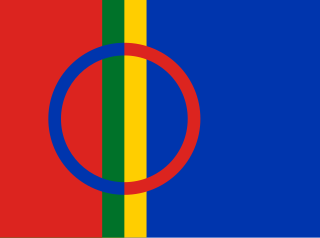
The Sámi are a Finno-Ugric-speaking people inhabiting the region of Sápmi, which today encompasses large northern parts of Norway, Sweden, Finland, and of the Murmansk Oblast, Russia, most of the Kola Peninsula in particular. The Sámi have historically been known in English as Lapps or Laplanders, but these terms are regarded as offensive by the Sámi, who prefer the area's name in their own languages, e.g. Northern Sámi Sápmi. Their traditional languages are the Sámi languages, which are classified as a branch of the Uralic language family.

Savoonga is a city in Nome Census Area, Alaska. It is located on St. Lawrence Island in the Bering Sea. As of the 2020 census, Savoonga's population was 835, up from 671 in 2010.
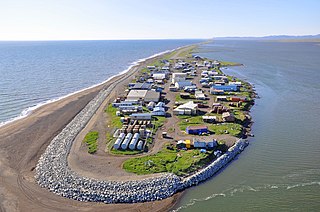
Kivalina(kiv-uh-LEE-nuh) is a city and village in Northwest Arctic Borough, Alaska, United States. The population was 377 at the 2000 census and 374 as of the 2010 census.

A sled dog is a dog trained and used to pull a land vehicle in harness, most commonly a sled over snow.

St. Lawrence Island is located west of mainland Alaska in the Bering Sea, just south of the Bering Strait. The village of Gambell, located on the northwest cape of the island, is 50 nautical miles from the Chukchi Peninsula in the Russian Far East. The island is part of Alaska, but closer to Russia than to the Alaskan mainland. St. Lawrence Island is thought to be one of the last exposed portions of the land bridge that once joined Asia with North America during the Pleistocene period. It is the sixth largest island in the United States and the 113th largest island in the world. It is considered part of the Bering Sea Volcanic Province. The Saint Lawrence Island shrew is a species of shrew endemic to St. Lawrence Island.

The siida is a Sámi local community that has existed from time immemorial. A siida, or 'reindeer pastoralistic district,' is a Sámi reindeer foraging area, a group for reindeer herding and a corporation working for the economic benefit of its members. The reindeer-herding siida has formed as an adaptation of ancient siida principles to large-scale nomadic reindeer herding. It is termed a sameby in Swedish law, reinbeitedistrikt in Norwegian law, and paliskunta in Finnish law. The pastoralist organisation differs slightly between countries, except in Russia, where kolkhoz replaced these earlier organisations.

The Alaska Statehood Act was a statehood admission law, introduced by Delegate E.L. Bob Bartlett and signed by President Dwight D. Eisenhower on July 7, 1958, allowing Alaska to become the 49th U.S. state on January 3, 1959. The law was the result of a multiple decade effort from many Alaskans such as Bartlett, Ernest Gruening, Bill Egan, Bob Atwood and Ted Stevens.

The Porcupine caribou(Rangifer tarandus groenlandicus) is a herd or ecotype of barren-ground caribou, the subspecies of the reindeer or caribou found in Alaska, United States, and Yukon and the Northwest Territories, Canada. A recent revision changes the Latin name; see Taxonomy.

William Thomas Lopp, known better professionally as W. T. Lopp, and to his family as Tom Lopp, was a member of the Overland Relief Expedition in Alaska, then a U.S. territory. He was a missionary and advocate of turning native hunters into self-sufficient reindeer herders. Lopp Lagoon, an 18 mi. long bay near where Lopp lived in Alaska, is named after him.
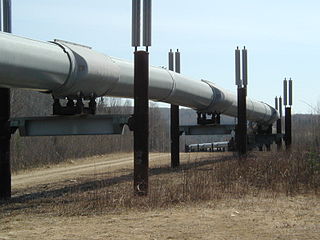
In a report compiled by the Alaskan Government, the real GDP of Alaska was $51.1 billion in 2011, $52.9 billion in 2012 and $51.5 billion in 2013. The drop-off that occurred between 2012 and 2013 has been attributed to the decline in the mining sector, specifically the oil and gas sectors, a consequence of declined production. The state's economy has been described by University of Alaska Anchorage economist Scott Goldsmith as a "three-legged stool" - with one leg being the petroleum and gas industry, the second leg being the federal government and the third leg being all other industries and services. Between 2004 and 2006, the federal government was responsible for 135,000 Alaska jobs, the petroleum sector provided 110,000 jobs and all other industries and services combined for 122,000 jobs.
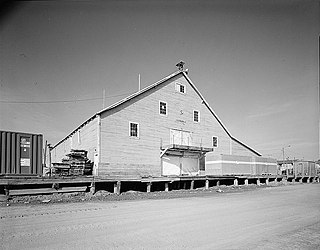
Lomen Company was an American meatpacking industry, founded in 1914 by brothers Carl and Alfred Lomen in the then Territory of Alaska.
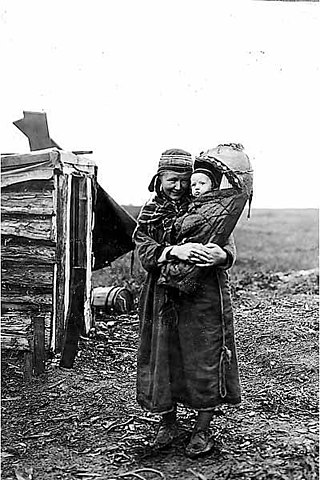
Sámi Americans are Americans of Sámi descent, who originate from Sapmi, the northern regions of Norway, Sweden, Finland, and the Kola Peninsula of Russia. The term Lapp Americans has been historically used, though lapp is considered derogatory by the Sámi.
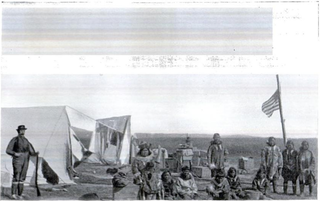
Teller Reindeer Station was located near Teller in the U.S. state of Alaska. The idea of transporting domestic reindeer from Siberia to western Alaska was first suggested by Captain Michael A. Healy, an officer in the United States Revenue Cutter Service, as a possible solution to the Native Alaskans' food shortage problem. The station was established in 1892 by Sheldon Jackson, Commissioner of Education in Alaska and a Presbyterian minister, who named it in honor of Henry M. Teller. The U.S. Government's Alaska Reindeer Service program ended in the early 1900s.

Alaska Reindeer Service (ARS) was established for the benefit of the U.S. territory of Alaska by Congressional action on 3 March 1893. The ARS was an integral part of the educational system of northern and western Alaska. The superintendent of education of Alaska Natives had general supervision of the work. The district superintendents in northern and western Alaska were supervisors of the reindeer industry within their districts. The first annual expenditure for the period of 1893-94 was US$5,998.
Environmental racism is a form of institutional racism leading to disposal of hazardous waste being disproportionally placed in communities of colour. It also results in indigenous people disproportionately bearing the environmental burdens of mining, and oil or gas extraction. In Russia, there are 47 officially recognized indigenous groups, who have had some rights to consultation and participation under Russian law since 1999. However, these guarantees have steadily eroded with the re-centralization of state control, and several indigenous autonomous territories have been abolished.

The Sámi Assembly of 1917 was the first Sámi National Assembly. The Sámi who took part in the assembly were from both Norway and Sweden. The meeting was held at the Methodist Church in Trondheim from 6 to 9 February 1917. The Sámi National Day is celebrated on 6 February to commemorate the beginning of this assembly. Around 150 participants gathered at the assembly, of which the majority consisted of Southern Sámi from Nordland, Trøndelag and Hedmark.

Reindeer herding is when reindeer are herded by people in a limited area. Currently, reindeer are the only semi-domesticated animal which naturally belongs to the North. Reindeer herding is conducted in nine countries: Norway, Finland, Sweden, Russia, Greenland, Alaska, Mongolia, China and Canada. A small herd is also maintained in Scotland.

The St. Lawrence Island famine killed around 1000 people on St. Lawrence Island in the Bering Sea off the Alaskan mainland during the years 1878–1880. Possible causes may have been overfishing, disease, or negative aspects of settler contact.

Reindeer Station is an uninhabited locality in the Northwest Territories, Canada. It is located in the Caribou Hills, along the Mackenzie River's eastern channel. The community was established in 1932 to house a herd of 3,442 reindeer purchased by the Government of Canada. The venture was intended to replace the traditional livelihood of the local Indigenous peoples, but few chose to become reindeer herders, so the government eventually sold the animals and Reindeer Station was abandoned in 1969. Most of its residential buildings were relocated to the larger centres of Tuktoyaktuk and Inuvik.


















